Apparent Specific Gravity Of Aggregate
Overview
The coarse aggregate specific gravity test (Figure 1) is used to calculate the specific gravity of a coarse aggregate sample by determining the ratio of the weight of a given book of amass to the weight of an equal volume of water. Information technology is like in nature to the fine aggregate specific gravity test.
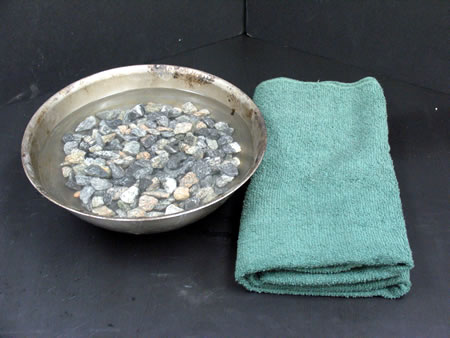
The fibroid aggregate specific gravity test measures coarse aggregate weight under iii different sample weather:
- Oven-dry out (no water in sample).
- Saturated surface-dry out (SSD, water fills the amass pores).
- Submerged in water (underwater).
Using these three weights and their relationships, a sample's apparent specific gravity, bulk specific gravity and bulk SSD specific gravity as well equally absorption tin be calculated.
Aggregate specific gravity is needed to decide weight-to-volume relationships and to calculate various volume-related quantities such as voids in mineral amass (VMA), and voids filled by asphalt (VFA). Absorption tin can be used as an indicator of aggregate durability equally well as the volume of cobblestone binder it is likely to blot.
The standard fibroid aggregate specific gravity and absorption examination is:
- AASHTO T 85 and ASTM C 127: Specific Gravity and Assimilation of Coarse Aggregate
Groundwork
Specific gravity is a measure of a material'due south density (mass per unit of measurement book) as compared to the density of water at 73.4°F (23°C). Therefore, by definition, water at a temperature of 73.4°F (23°C) has a specific gravity of 1.
Assimilation, which is also determined by the same test procedure, is a measure of the amount of water that an aggregate can absorb into its pore structure. Pores that absorb water are also referred to as "water permeable voids".
Specific Gravity Employ
Aggregate specific gravity is used in a number of applications including Superpave mix pattern, deleterious particle indentification and separation, and fabric property change identification.
Superpave Mix Design
Superpave mix design is a volumetric process; it relies on mixing constituent materials on the basis of their volume. However, aggregate and asphalt binder volumes are diffucult to mensurate directly, therefore a material's weight is typically measured and then converted to a volume based on its specific gravity. Correct and accurate textile specific gravity determinations are vital to proper mix pattern. An incorrect specific gravity value will result in incorrect calculated volumes and ultimately result in an incorrect mix design.
Material Contamination Indicator and Separator
Specific gravity can also signal possible cloth contagion. For instance, deleterious particles (Effigy 2) are often lighter than aggregate particles and therefore, a large amount of deleterious textile in an aggregate sample may result in an abnormally low specific gravity.
Material Alter Indicator
Finally, specific gravity differences can exist used to indicate a possible material modify. A change in aggregate mineral or physical properties tin can event in a change in specific gravity. For example, if a quarry operation constantly monitors the specific gravity of its output aggregate, a change in specific gravity beyond that commonly expected could indicate the quarrying has moved into a new rock formation with significantly dissimilar mineral or physical properties.
Aggergate Assimilation Use
Aggregate absorption is the increase in mass due to water in the pores of the textile. Aggregate absorption is a useful quality because:
- High values tin indicate non-durable aggregate.
- Absorption tin can bespeak the amount of cobblestone binder the aggregate will absorb.
It is generally desirable to avoid highly absorptive aggregate in HMA. This is because asphalt binder that is absorbed by the aggregate is not bachelor to coat the amass particle surface and is therefore not available for bonding. Therefore, highly absorptive aggregates (oftentimes specified every bit over 5 percent assimilation) require more asphalt folder to develop the same film thickness as less absorbent aggregates making the resulting HMA more expensive.
Aggregate Specific Gravity Types
Several unlike types of specific gravity are usually used depending upon how the volume of h2o permeable voids (or pores) within the amass are addressed (Figure three):
- Apparent Specific Gravity, Gsa. The volume measurement only includes the volume of the amass particle; it does not include the book of any water permeable voids. The mass measurement only includes the amass particle. Apparent specific gravity is intended to just measure the specific gravity of the solid volume, therefore it will be the highest of the amass specific gravities. Information technology is formally defined as the ratio of the mass of a unit book of the impermeable portion of aggregate (does non include the permeable pores in amass) to the mass of an equal volume of gas-free distilled water at the stated temperature.
- Bulk Specific Gravity (Majority Dry Specific Gravity), 1000sb. The volume measurement includes the overall volume of the amass particle equally well as the volume of the water permeable voids. The mass measurement only includes the aggregate particle. Since it includes the water permeable void volume, bulk specific gravity will exist less than credible specific gravity. It is formally defined as the ratio of the mass of a unit volume of aggregate, including the water permeable voids, at a stated temperature to the mass of an equal volume of gas-free distilled h2o at the stated temperature.
- Majority Saturated Surface Dry (SSD) Specific Gravity. Book measurement includes the overall volume of the aggregate particle equally well as the volume of the h2o permeable voids. The mass measurement includes the amass particle likewise equally the water within the water permeable voids. It is formally divers as the ratio of the mass of a unit volume of amass, including the weight of water inside the voids filled to the extent achieved by submerging in h2o for approximately xv hours, to the mass of an equal volume of gas-free distilled h2o at the stated temperature.
- Effective Specific Gravity, Mse. Volume measurement includes the volume of the aggregate particle plus the void volume that becomes filled with h2o during the examination soak period minus the volume of the voids that absorb asphalt. Effective specific gravity lies between apparent and bulk specific gravity. It is formally divers every bit the ratio of the mass in air of a unit volume of a permeable material (excluding voids permeable to cobblestone) at a stated temperature to the mass in air (of equal density) of an equal volume of gas-costless distilled water at a stated temperature. Effective specific gravity is adamant by a different procedure and is not covered in this section.
Relationship with Other Specific Gravities
Refer to Figure iv for abbreviations.
- The difference between Gsa and Gsb is the volume of amass used in the calculations. The difference between these volumes is the volume of absorbed water in the aggregate's permeable voids. Both use the aggregate's oven dry out weight.
- The difference between Gsb and bulk (SSD) specific gravity is the weight of amass used in the calculations. The departure betwixt these weights is the weight of absorbed water in the aggregate's permeable voids. Both use the same aggregate volume.
- The difference between Gsa, Gse and Gsb is the volume of aggregate used in the calculations. All iii use the aggregate's oven dry weight.
- The following relationships are always true:
- Gsa ≥ Gse ≥ Gsb
- Bulk (SSD) specific gravity ≥ Gsb
- Aggregate specific gravities (Gsb, Gsa,Gse and majority SSD specific gravity ) are all ≥ Gmm(because Gmm includes the asphalt binder, which has a lower specific gravity than the aggregate)
Test Description
The following description is a brief summary of the test. Information technology is non a complete procedure and should not be used to perform the test. The complete procedure can be found in:
- AASHTO T 85 and ASTM C 127: Specific Gravity and Absorption of Coarse Amass
Summary
The mass of a coarse aggregate sample is determine in SSD, oven-dry and submerged states. These values are then used to summate bulk specific gravity, bulk SSD specific gravity, apparent specific gravity and absorption. Effigy five shows major fibroid aggregate specific gravity equipment.
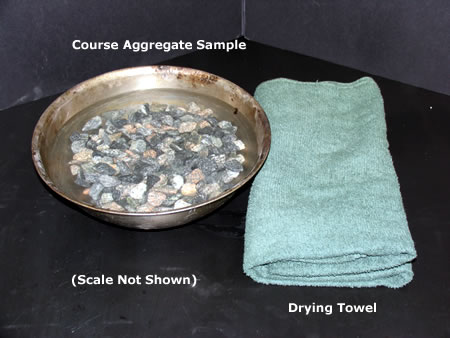
Approximate Exam Fourth dimension
3 days (from sample preparation to final dry out weight determination)
Basic Procedure
1. Obtain a sample of coarse aggregate material retained on the No. 4 (4.75 mm) sieve (Figure half dozen). This sample size is based on nominal maximum aggregate size (NMAS). Sample sizes range from 2000 m for a 0.5 inch (12.5 mm) NMAS to 5000 g for a 1.5 inch (37.5 mm) NMAS.
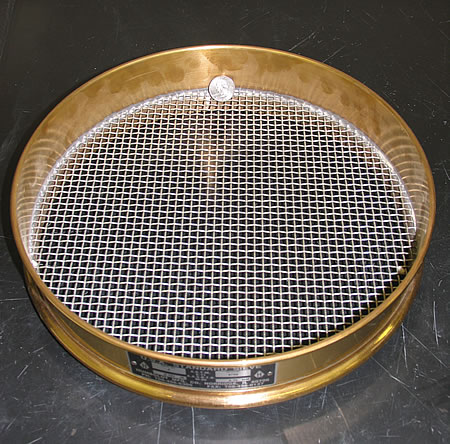
2. Prepare the material.
- Wash the aggregate retained on the No. 4 (4.75 mm) sieve. This discards pocket-size amass particles clinging to the retained big particles.
- Dry the material until information technology maintains a constant mass. This indicates that all the water has left the sample. Drying should occur in an oven regulated at 230°F (110°C).
- Cool the amass to a comfortable handling temperature.
- Immerse the aggregate in water at room temperature for a period of 15 to 19 hours (Figure vii).
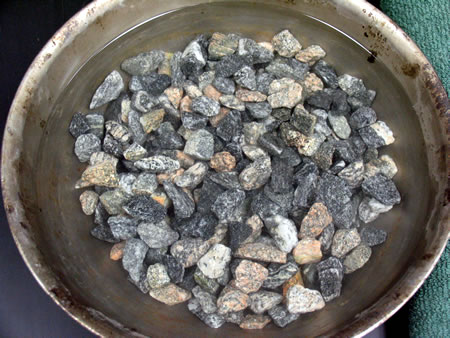
If the aggregate is non oven-dried before soaking, specific gravity values may be significantly college. This is considering in the normal procedure the h2o may non be able to penetrate the pores to the center of the aggregate particle during the soaking time. If the aggregate is not oven-dry to start, the existing water in the aggregate pore structrure may be able to penetrate further into the pores (AASHTO, 2000c[1]).
3. Dry the sample to a saturated suface dry (SSD) condition. Rolling upwards the aggregate into the towel and and then shaking and rolling the aggregate from side to side is usually effective in reducing the sample to a SSD condition (Video 1). It may be necessary to wipe the larger particles separately. Once there are no visible signs of water film on the aggregate particle surfaces, make up one's mind the sample mass.
Make certain to use material and non paper towels. Paper towels may blot water in the aggregate pores.
Video 1: Drying a CASG sample.
iv. Place the entire sample in a basket (Figure viii) and counterbalance it underwater (Effigy ix). The basket should exist pre-conditioned to the water bath temperature. Shake the container to release any entrapped air earlier weighing. The container overflow needs to work properly to compensate for the water displaced by the sample.
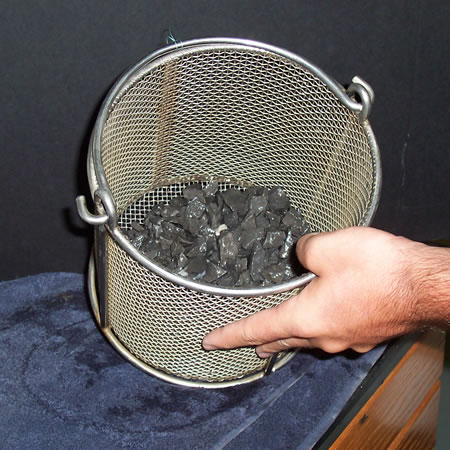 | 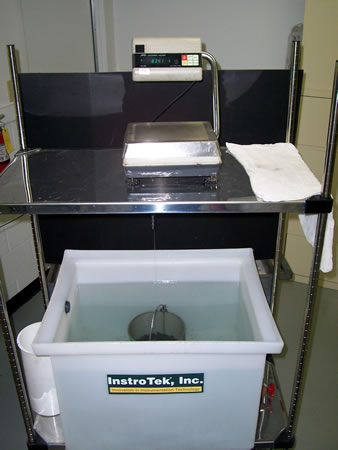 |
5. Remove the aggregate from the water and dry it until it maintains a constant mass. This indicates that all the water has left the sample. Drying should occur in an oven regulated at 230°F (110°C).
6. Cool the aggregate in air at room temperature for 1 to 3 hours then determine the mass.
Results
Parameters Measured
- Coarse aggregate bulk specific gravity.
- Coarse amass bulk SSD specific gravity.
- Coarse amass apparent specific gravity.
- Fibroid aggregate absorption.
Specifications
There are no minimum or maximum specific gravity or absorption values in Superpave mix design. Rather, specific gravity is an aggregate quality needed to make required volume calculations. Some state agencies specify minimum aggregate specific gravities or maximum per centum water absorption to help control amass quality.
Typical Values
Specific gravities can vary widely depending upon amass type. Some lightweight shales (not used in HMA production) can accept specific gravities near 1.050, while other aggregate can take specific gravities above iii.000. Typically, aggregate used in HMA production will have a bulk specific gravity betwixt almost 2.400 and three.000 with ii.700 being fairly typical of limestone. Bulk SSD specific gravities tin be on the club of 0.050 to 0.100 higher than bulk oven dry out specific gravities, while apparent specific gravities tin be 0.050 to 0.100 higher still.
For a particular aggregate type or source, fine aggregate specific gravities tin be slightly higher than coarse aggregate specific gravities considering every bit the aggregate particles become smaller, the fraction of pores exposed to the aggregate surface (and thus excluded from the specific gravity calculation considering they are water-permeable) increases.
Aggregate absorption can also vary widely depending upon aggregate type. Some lightweight shales (not used in HMA product) tin can have absorptions approaching 30 percent, while other aggregate types can have near zero absorption. Typically, aggregate used in HMA production will have an assimilation between simply above zero and v percent. Absorptions above about v per centum tend to make HMA mixtures uneconomical because actress asphalt binder is required to business relationship for the high aggregate absorption.
If assimilation is incorrectly accounted for, the resulting HMA could be overly dry out and take low immovability (absorption calculated lower than it actually is) or over-asphalted and susceptible to baloney and rutting (assimilation calculated higher than it actually is).
Calculations
![]()
![]()
![]()

Iii unlike masses are recorded during the test. Their common symbols are:
A = mass of oven-dry sample in air (g)
B = mass of SSD sample in air (grand)
C = mass of SSD sample in h2o (g)
These masses are used to summate the various specific gravities and assimilation using the post-obit equations:
Note that the quantity (B – C) is the mass of water displaced by the SSD amass sample. In the apparent specific gravity adding the mass of the SSD aggregate sample is replaced by the mass of the oven-dry out amass sample (A replaces B), which means that the water permeable voids within the aggregate are not included and (A – C) is the mass of water displaced past the oven-dry sample.
The ratios given in the equations are then simply the ratio of the weight of a given volume of aggregate to the weight of an equal volume of h2o, which is specific gravity.
Certainly, the accuracy of all measurements is important. However, of specific concern is the mass of the SSD sample. The determination of SSD atmospheric condition can be difficult. If the sample is actually still wet on the surface then the mass of the SSD sample will be higher than it ought to be, which volition crusade a lower calculated bulk specific gravity. Conversely, if the sample is beyond SSD and some of the pore water has evaporated (which is more than probable), the mass of the SSD sample will be lower than it ought to be, which will crusade a higher calculated bulk specific gravity. Either blazon of mistake will take a cascading result on volumetric parameters in other tests that crave specific gravity as an input and Superpave mix design.
A quick check of the results should show that majority specific gravity is the lowest specific gravity, bulk SSD specific gravity is in the middle and credible specific gravity is the highest.
Apparent Specific Gravity Of Aggregate,
Source: https://pavementinteractive.org/reference-desk/testing/aggregate-tests/coarse-aggregate-specific-gravity/
Posted by: walkerpuring93.blogspot.com


0 Response to "Apparent Specific Gravity Of Aggregate"
Post a Comment